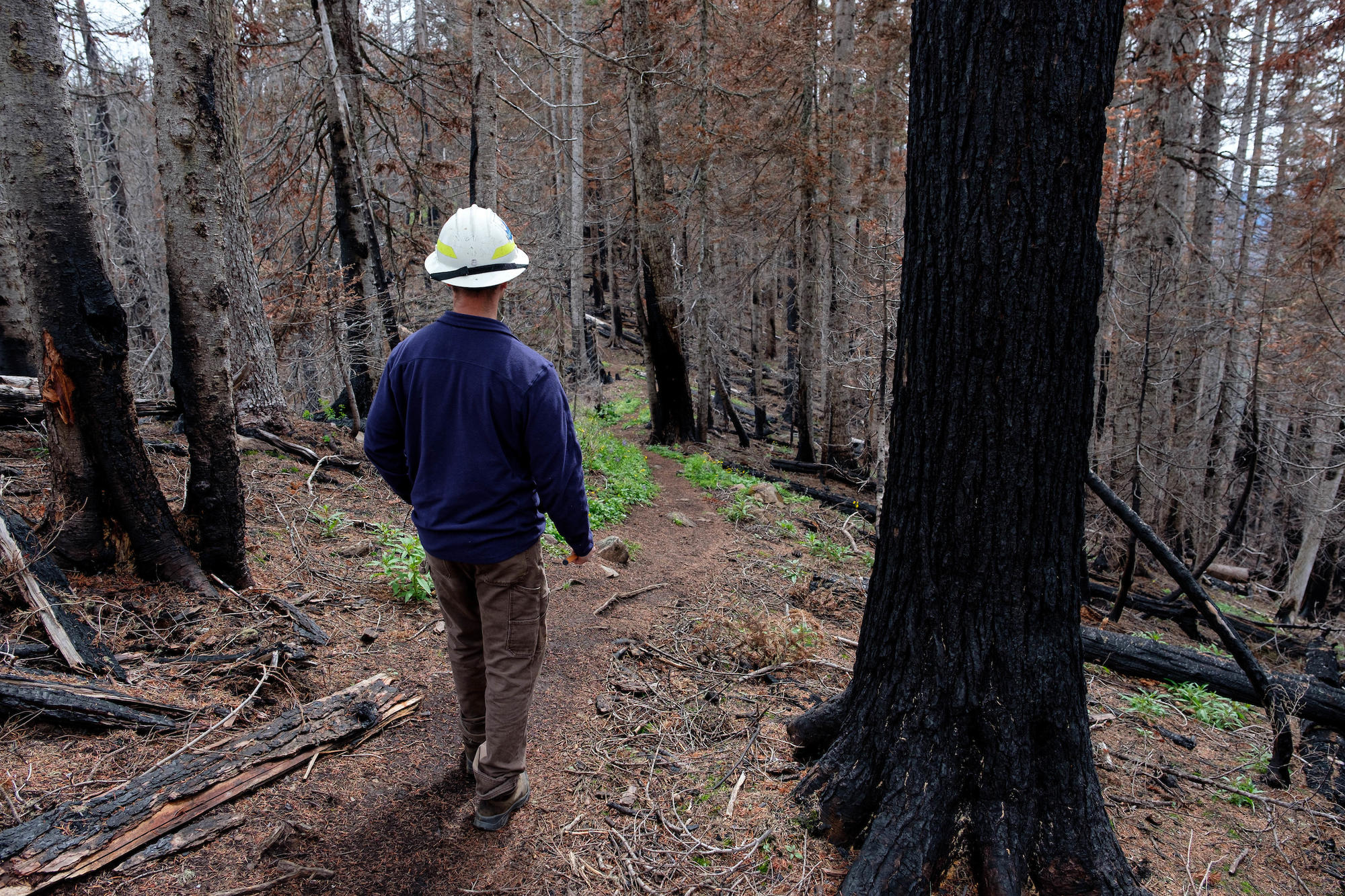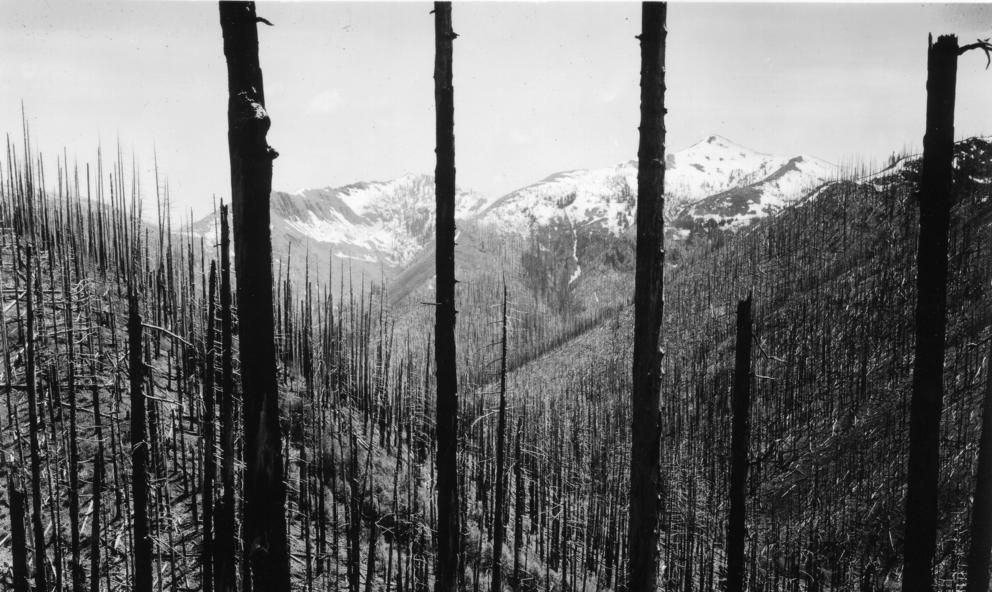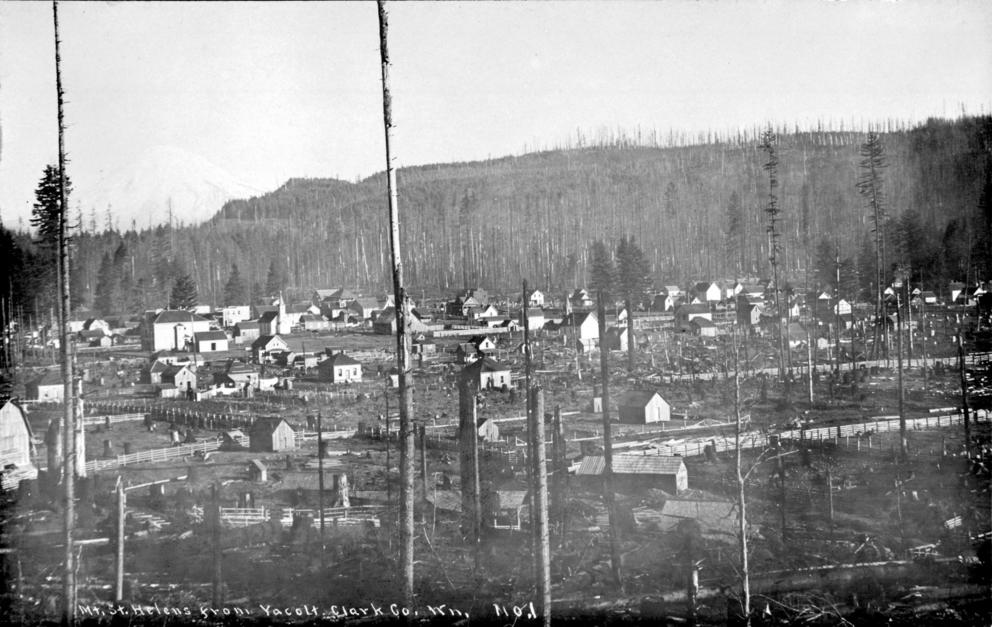Daniel Donato, a forester who works at the Washington state Department of Natural Resources and studies Western Washington fires, says big fires here are a bit like earthquakes. He jokingly refers to megafires as “Cascadia subduction fires,” referencing the major fault off the Washington coast that is vulnerable to slip and catalyze a massive 9.0 quake. The last time it did so was in 1700. Around then, there was a massive fire, or series of fires, in Western Washington that burned an astonishing 3 million to 10 million acres, according to a 1989 report by forest ecologist Jan Henderson. The trees that grew afterward constitute most of what we know as our old-growth forests.
Donato works with DNR research scientist Josh Halofsky, who researches how fires and other disturbances impact forest sustainability. The two are lean and fit, friends who studied together at Oregon State University and spend a lot of time working in the woods. “We are by no means trying to incite panic,” Halofsky says. “Fire is a natural part of what it means to live on the west side.” Understanding it will help us recognize the patterns, risks and causes. It can also help do away with the “it-can’t-happen-here” myth.

Earlier this summer, I stood with Donato and Halofsky in a spot that makes this very point. We were on a Cascade ridge on the west side between Mount Rainier and Crystal Mountain. It was the site, in August 2017, of the Norse Peak fire, the worst in Western Washington since the Yacolt Burn of 1902 (more about that in a bit). The blaze, caused by multiple lightning strikes, started on the east side of the mountains near Naches Pass. It spread westward, driven by east winds, jumped the Cascade crest in rough terrain and wasn’t contained until two months later. It burned some 55,000 acres.
We were at the edge of the burn, where a thick forest of Douglas and Noble firs thrive. But the Norse Peak fire left behind a skinny zombie army of brown and blackened matchsticks, which contrast sharply with the surviving forest. The Norse Peak fire burned hot. Some fires pass through a forest burning undergrowth and scorching mature, old trees, many of them with coats of thick fire-resistant bark that have caused some to call Doug fir stands “asbestos forests.” But not here this time. This blaze killed everything in its path, including trees over 200 years old.
West side forests are generally rich with growth — what firefighters think of as fuel. But, because they are damp, they are fairly fire resistant, and they grow in cooler climates than, say, the pine forests east of the mountains. They can burn, but the burns are often slow, smaller and of lower intensity. They linger but don’t rampage.
But when a fuel-rich forest gets tinder dry, watch out. Northwest writer Stewart Holbrook, in his 1945 history of forest fires, Burning an Empire, wrote, “A Doug fir jungle has almost the same explosive properties as a pile of gunpowder, a great big pile.” As a former logger and journalist, Holbrook had seen it firsthand.
It is not the first time the area has burned, however. Standing on a ridge near the Norse Peak Trailhead — a popular hike that starts at about 4,000 feet — the foresters pointed to a higher ridge across the way. It was bare of trees near the ridgeline, but below you could see various layers of tree growth of different ages. In a valley below, there was old growth that likely sprouted after a fire in the late 1600s. Above that was a layer of mature but younger trees, courtesy of a fire from about 1900. And then, nearby where we stood, there were the freshly charred burn remnants from 2017.
It is also a fact that Native peoples routinely and seasonally burned parts of this landscape, as well as many others, with prescribed burns designed to “feed the people,” according to tribal historian Warren King George of the Muckleshoot Indian Tribe. The Muckleshoot, whose reservation is near Auburn, have burned in these hills for millennia to promote the growth of huckleberries and encourage vegetation to draw out browsing deer and elk for hunting. The last burn of that kind took place on a hillside at nearby Bone Lake in 1940, he says. There are accounts of people going into the mountains to pick berries and hunt game, returning at the end of the season attended by smoke in the valleys from burns in the hills.
“There is no patch of ground on the west side that has not felt a significant fire in the past,” says Donato.
But not all fires are equal. While indigenous peoples burned the landscape, fires clearly increased along with settlement expansion, especially in the era before firefighters, lookouts and fire-suppression methods. Settlers burned stump fields to clear the land. Loggers conducted slash burns in the summer to clean up the mess after clearcutting forests, steam engines from trains and logging equipment sent sparks into the dry woods, settlers and campers built campfires and left them burning. It was a time before Smokey Bear.
Historically, there are two catastrophic fires that have burned themselves into the west side record books: The Yacolt Burn of 1902, in Washington, and the Tillamook Burn in Oregon. These set the bar for post-settlement megafires. The foresters say massive fires west of the mountains have three things in common. They occur when the forests are exceedingly dry — a summer dry spell of little rain and low humidity. They require some kind of ignition, like lightning without rain or a spark from human activity. And the third secret ingredient is a strong east wind that acts like a bellows to fan the flames. Virtually every major fire west of the Cascades has been driven by such winds, says University of Washington meteorologist Cliff Mass.
The Yacolt Burn, first spotted in Lewis County from Kalama, was actually a complex of fires, mostly in southwest Washington but also reaching across the Columbia River into Oregon. A hot, extremely dry summer was whipped into a frenzy of flame on Sept. 11, 1902. It was so bad that people in Olympia, according to Stewart Holbrook, thought the smoke, ash and visible wall of flames meant that Mount Rainier had erupted.
Near the Lewis River area, farmers and ranchers fled, but many were burned alive by the fast-moving flames. “The flames had come so swiftly,” Holbrook wrote, “they had caught 35 fleeing humans and burned them to crisps. A score of villages and settlements had been wiped out.” At least 65 people died. Oddly, the town of Yacolt was saved, but the flames came close enough to blister paint.
Simultaneously, other fires broke out all over the region, from Snohomish to Eugene and Astoria, Ore., because of the dry and windy conditions. Josh Halofsky says the immediate Yacolt complex burned about 240,000 acres, mostly in Washington, but speculates that the combination of all the simultaneous fires in Western Washington and Oregon that month could have boosted the total figure to a million acres. In the end, rain put the fires out.
Another massive fire worth noting occurred in the coast range of Oregon in August 1933 — the so-called Tillamook Burn. A tinder dry summer had halted most logging operations for safety reasons, but one outfit kept working and a spark, generated while hauling a log, lit a fire in the firs, a fire “so uncalled for,” wrote Holbrook, “the gods must have wept.” Loggers and members of the Civilian Conservation Corps tried to contain the blaze and were making progress until a hot, dry east wind swept in, transforming the forest into a fast-moving blowtorch. More than 300,000 acres, much of it old-growth Doug fir, burned; 270,000 acres were vaporized in a single 24-hour period. In those days, forest losses were rarely discussed in terms of habitat or environmental damage. Fighting fires was about the timber economy. Holbrook estimated that some 12.5 billion board feet of timber went up in flames, enough lumber to supply every mill in the 48 states for a year.
In the latter part of the 20th century, comparatively cool weather, fire suppression, reforms in logging and land-use practices, better firefighting capabilities and new technologies, like satellite tracking, have helped keep west Cascades wildfires off the megafire scale. Still, with more people living near the woods, memories of the disastrous burn last year in California that destroyed the town of Paradise, and years with low snowpack and the possibility of drier, longer summers are giving rise for concern. So, too, is the growing population: Humans are still the main cause of wildfires. More people equals more potential ignitions. Remember the Eagle Creek fire that burned in the Columbia Gorge in 2017? It was triggered by a kid throwing fireworks into the woods.
And then there are those east winds, which can be every bit as strong as California’s notorious Santa Ana winds. One piece of possible good news, Cliff Mass says, is that with climate change, models suggest these winds could probably lessen. Foresters Donato and Halofsky want to study the wind phenomenon more thoroughly and its connections with forest management (windstorms also can do a great deal of damage). Understanding the makeup of future forests, the impact of terrain, weather and fire behavior might be critical to dealing with the fires next time.
As evidenced on the site of the Norse Peak fire and the layers of trees revealing cycles of fire, growth and more fire, recovery can take centuries, but it does happen. As we stood on the ridge of the Norse Peak trail, patches of wildflowers — including large and fiery red Indian paintbrush — were blooming, grasses were growing, mushrooms were sprouting from the ashes, and mountain bluebirds were flittering through the burn, their sky blue feathers a gorgeous contrast against the charred dead trees. Burned-over areas are where new fir saplings can thrive, restoring the forests that grow so prolifically here. No one wants catastrophic fires, but perhaps we can muster some hope from nature’s resilience and its cycle of renewal.






